中考英语动词时态复习
中考英语总复习动词时态归纳总结
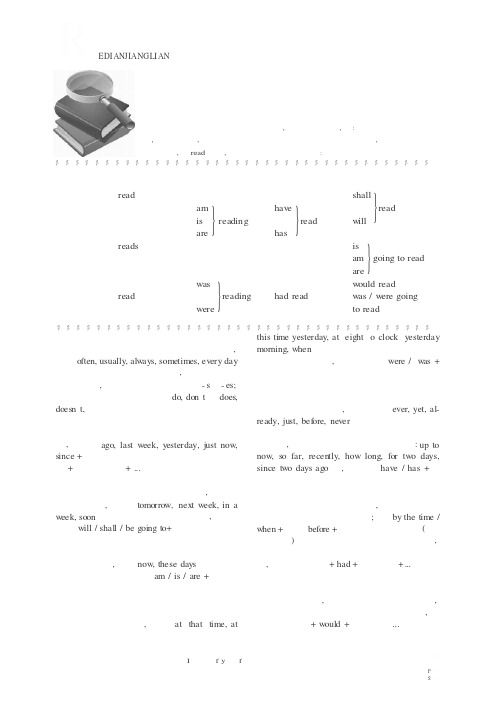
一般 时态 read 现
在 reads
过 read
去
进 行进 态
}am
is reading are
完 成时 态
}have read has
}was reading were
had read
将 来时 态
}shall read will
人称单数时, 实义谓语动词应在其后加- s 或- es;
六、现在完成时
构成疑问 句或否 定句时借 助 do, don’t 或 does,
现 在完成 时指过去 发生的 某一动作 对现
doesn’t, 谓语动词应用原形。
在 造成的影响 或结果, 此 时常与 ever, yet, al-
二、一般过去时
ready, just, before, never 等 时间状 语连 用。也
一般现在时表示经常性或习惯性的动作, morning, when 引导的 时间 状语从 句等表 示过
常与 often, usually, always, sometimes, every day 去的 时间状语连用, 谓语动 词由“were / was +
等时间状语连用。一般现在时中, 当主语是第三 现在分词”构成。
语 + 动词过去式 + ...”。
2023年英语中考语法总复习—8.动词时态和语态
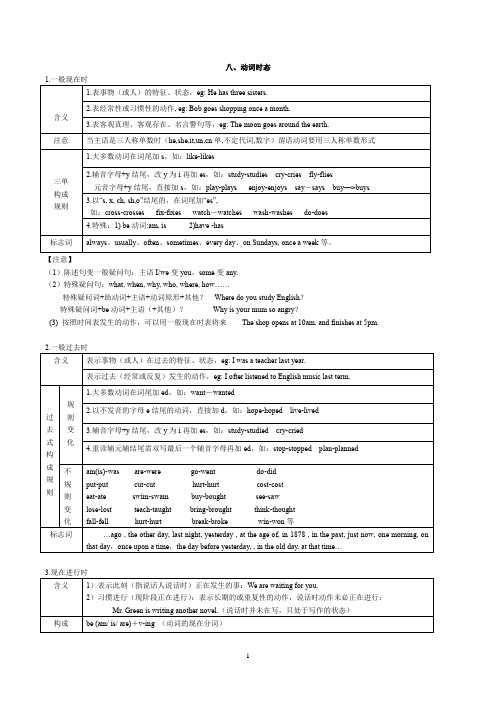
八、动词时态【注意】(1)陈述句变一般疑问句:主语I/we变you,some变any.(2)特殊疑问句:what, when, why, who, where, how……特殊疑问词+助动词+主语+动词原形+其他?Where do you study English?特殊疑问词+be动词+主语(+其他)?Why is your mum so angry?(3) 按照时间表发生的动作,可以用一般现在时表将来The shop opens at 10am. and finishes at 5pm.【注意】(1)always也可用于现在进行时,表示一种强烈的感情色彩,译为“总是”He is always telling lies.(2)某些特殊动词不能用于现在进行时。
① have当“有”讲时,不能用现在进行时。
I have two books now.②“belong to” The two people belong to me now.③表示“心理活动/状态/感觉”的词I want a dog now.① be going to主要用于:主观判断(1)表示事先经过考虑、安排好打算要做的事情:I’m going to play the violin.(2)表示根据目前某种迹象判断,某事非常有可能发生(有迹象表明要发生的事)。
Look!There come the dark clouds. It is going to rain.② will主要用于:(1)客观上将来势必发生的事情, 未经事先考虑, 临时决定的They will go to visit the factory tomorrow.(2)表示不以人的意志为转移的自然发展的未来的事:Today is Saturday. Tomorrow will be Sunday.(3)表意愿。
问对方是否愿意做某事或表示客气地邀请或命令:Will you please turn on the radio?(1) have/has been to “去过已回”She has been to Japan twice.have/has gone to. “去了未回”Where is your twin sister? She has gone to Japan.have/has been in “待在某地” She has been in Japan for 2 years. (2) 动词从词义上可以分为延续性和非延续性两种。
中考英语复习资料

中考英语复习资料中考英语复习资料11.动词的八种时态的构成及用法;2.动词被动语态的构成及用法;3.非谓语动词的构成及用法;4.近义动词的用法区别。
【名师点睛】1.动词的时态英语时态用共有十六种时态,其中常用的有8种,它们是:一般现在时、一般过去时、一般将来时、现在进行时、现在完成时、过去进行时、过去完成时和过去将来时。
(1)一般现在时的基本用法1) 经常性或习惯性的动作,常与表示频度的时间状语连用。
时间状语:every…, sometimes,at…, on SundayI leave home for school at 7 every morning.2) 客观真理,客观存在,科学事实。
The earth moves around the sun.Shanghai lies in the east of China.3) 表示格言或警句中。
Pride goes before a fall.【注意】此用法如果出现在宾语从句中,即使主句是过去时,从句谓语也要用一般现在时。
例:Columbus proved that the earth is round..4) 现在时刻的状态、能力、性格、个性。
I dont want so much.5) 某些动词如come, go, move, stop, leave, arrive, be, finish, continue, start 等,在一般现在时句中可用来表示将来肯定会发生的动作。
The train comes at 3 oclock.6) 在时间状语从句或条件状语从句中,一般现在时代替一般将来时。
Ill help you as soon as you have problem.Tell Xiao Li about it if you meet him.(2)一般过去时的用法:表示过去某一时刻或某一段时间内所发生的动作或情况,通常一般过去式带有表示动作时间状语的词,词组或从句,如yesterday, the day before last, last week, two days ago 等,上下文清楚时可以不带时间状语。
2023年中考英语复习动词时态、语态 课件

He joined the League three years ago. ( 三年前入团,joined为短暂行为。)
I have finished my homework now. ---Will somebody go and get Dr. White? ---He's already been sent for.
I'd rather you came tomorrow.
4) wish, wonder, think, hope 等用过去时,作试探性 的询问、请求、建议等。如:
I thought you might have some. 我以为你想要一些。
比较:
一般过去时表示的动作或状态都已成为过去,现已 不复存在。
He is used to a vegetarian diet. Scarf is used to taking a walk.(现在习惯于散步)
典型例题
---- Your phone number again? I _A__ quite catch it. ---- It's 69568442. A. didn't B. couldn't C. don't D. can't
3) be +不定式表将来,按计划或正式安排将发 生的事。如:
We are to discuss the report next Saturday. 4) be about to +不定式,意为马上做某事。如:
He is about to leave for Beijing. 注意:be about to 不能与tomorrow, next week 等表示明确将来时的时间状语连用。
中考英语第二轮语法复习-动词的时态

1. 句子基本结构:
(1)would/should + do. 如:she said that she would have a party for her daughter
(2)was/were going to + do
(3)was/were doing 2. 用于主句为一般过去时,宾语从句表将要发生的事或曾打
(3)不用进行时态的情况
表示感觉、愿望和状态的某些பைடு நூலகம்词,如see, hear, smell, taste,
hope, like等。 表示拥有的动词,如have, own, belong等。
表示理解、记忆或决定的动词,如understand, know,
remember, forget, decide等。
介词to, in或at。
6. 有关短暂性动词
(1)短暂性动词在现在完成时中不能和表示一段时间的状语
连用,但在否定句中可以和表示一段时间的状语连用。 (2)短暂性动词不能出现在由how long引导的疑问句中,但
可以和already, never, just, ever, before等连用。
7. 短暂性动词的用法: (1)短暂性动词与短暂性时间(时间点)连用。如: He joined the Party three years ago. 他入党三年了。(他三年前入党的) (2)用“It is/has been+时间段+since...”句型。如: It is/has been three years since I bought the book. 这本书我买了三年了。(从买这本书起到现在已三年了) (3) 短暂性动词转换成延续性动词或形容词、介词等表状态 短语可与“for+时间段”或“since+时间点”连用。
2024中考英语真题专项复习动词时态含解析

动词时态01单项选择1.(2024浙江温州)8.—Have scientists found life on Mars?—Not yet, but I think they ________it some day.A.find B.found C.have found D.will find2.(2024贵州铜仁)34.一Maria, what do you think of Mount Fanjing?- Very cool. I____ there once. I'd like to go there again.A. has beenB. have beenC. have goneD. has gone3.(2024贵州黔东南州)28.—Would you like to go hiking if it ________ fine this Saturday?—I'd love to. But nobody knows if it________.A.is; will rain B.is; rains C.will be; will rain D.will be; rains4.(2024贵州黔东南州)33.—________did the rainstorm come, Mr. Liu?—While we ________ a chemistry lesson yesterday afternoon.A.When; have had B.When; were having C.While; are having D.While;have5.(2024贵州黔西南州)26.While Mike computer games in his room, his dad came in.A. is playingB. was playingC. will playD.plays6.(2024贵州黔西南州)31. —Peter, have you ever been to the English Corner? —Oh, yes. I there to practice speaking once a week last term.A. wentB. goC.have goneD. will go7.(2024重庆A)25. Listen! Our teacher ______in the music classroom.A. singsB. sangC. will singD. issinging8.(2024重庆B)26. Don't drink coffee before going to bed, or you____easily.A. don't fall asleepB. won't all asleepC. didn't fall asleepD. haven't fallen asleep9.(2024四川甘孜州)4.I ______ a math problem with Joe when Mike called me up. A.have discussed B.discussed C.was discussing10.(2024四川自贡)3.—Alice, have you finished learning the whole book? —Not yet. So far, we __________ six units.A.learned B.have learned C.learn11.(2024黑龙江齐齐哈尔市)8.—What were you doing at this time yesterday? —I _______ a movie named Lost in Russia directed by Xu Zheng.A.was seeing B.saw C.am seeing12.(2024黑龙江齐齐哈尔市)9.To avoid gathering (聚集), neither the students nor their head teacher _______ going to the party this evening.A.was B.are C.is13.(2024四川广元)9.—I asked him a question, but he didn't reply.—Maybe he ________about something else while you were asking.A.thought B.thinks C.was thinking14.(2024四川广元)14.Tom. together with his friends, often________ to the old people's home to cheer the old up.A.go B.going C.goes15.(2024黑龙江哈尔滨)13.—Hi, Jill. I ______ in my math since you shared your good experience with me.—Great! Congratulations!A.have made rapid progress B.made rapid progress C.will make rapid progress16.(2024四川凉山)5.--Jack, I'm busy doing the washing. Can you give me a hand? ---Wait a moment. I ______the bed.A.am making B.will make C.was making D.have made17.(2024四川凉山)8.--It's 20 years since we came back to Liangshan.--How time flies! We ________ in our hometown for such a long time.A.work B.worked C.has worked D.have worked18.(2024四川凉山)10.On January 29th, 2024, Zhong Nanshan and his team ________ over four hours online _________ five patients who were seriously ill, and made a treatment plan for those patients.A.spent; checking B.spent; to check C.spend; checking D.spend; tocheck19.(2024四川凉山)15.—Let's go camping if it_________ next Saturday.—But nobody knows if it ________.A.is fine; rains B.will be fine: rainsC.is fine: will rain D.will be fine: will rain20.(2024黑龙江牡丹江)11.The government _______ a new rule to stop young people playing video games for long. Nowadays many students spend less time online. A.will make B.is making C.has made21.(2024黑龙江牡丹江)13.—The talent show Youth With You (青春有你) is becoming hotter and hotter online.—Exactly. Half of our class ______ interested in it recently.A.is B.are C.was22.(2024黑龙江龙东地区(农垦))16.It has been two months since my father ________ for Italy.A.was left B.left C.leaves23.(2024黑龙江龙东地区(农垦))17.—No one can tell when they ________. —Wh en they ________, I’ll let you know at once.A.return; will arrive B.will return; reach C.will return; arrive24.(2024北京)7.If you take this train, you ______ in Shanghai in five hours. A.arrive B.will arrive C.arrived D.have arrived25.(2024北京)8.I ________ on the computer when Frank called me last night. A.work B.will work C.was working D.am working26.(2024北京)9.We ________ each other since I came to Beijing, but we send emails very often.A.don't see B.didn't see C.won't see D.haven't seen27.(2024北京)10.—What’s that noise, Sam?—My little brother _________ with his toy car now.A.will play B.is playing C.plays D.played28.(2024贵州安顺)14.Since 1990, Project Hope ________ millions of students from poor families realize their dreams.A.will help B.has helped C.helps29.(2024安徽)7.— The air here is much fresher than before.—Exactly! We a lot of trees in the past few years. A.planted B.were planting C.have planted D.will plant30.(2024黑龙江绥化市)4.Be quiet. Your grandmother ______ in the room. A.sleeps B.is sleeping C.sleep31.(2024黑龙江绥化市)9.We can't leave here until our teacher _______. A.will arrive B.arrives C.arrived32.(2024黑龙江绥化市)16.My family ______ for dinner now. We’re busy.A.is preparing B.are preparing C.prepares33.(2024黑龙江绥化市)24.By the time the teacher came, we ______ cleaning the classroom.A.finished B.have finished C.had finished34.(2024湖北鄂州)8.—What do you usually do in your spare time?—I often go to our community library. It ________ for two years in order to encourage us to read more.A.opens B.has opened C.has been opened D.has been open35.(2024湖北武汉)4.—Is Helen here?—Not yet, but she_________ in half hour.A.arrives B.will arrive C.arrived D.has arrived36.(2024湖北武汉)5.In the past 70 years, China________historic changes and made great achievements.A.experienced B.experiencesC.has experienced D.would experience37.(2024湖北武汉)6.Sally________ where she had left the car and the police found it this morning.A.forgot B.has forgotten C.forgets D.had forgotten38.(2024湖南怀化)7.In 2024,China ______ the 24th Winter Olympics (冬奥会) in Beijing.A.held B.hold C.will hold39.(2024湖南湘西)9.The world is changing with every minute, and China________ with every minute,too.A.is changing B.had changed C.changed40.(2024湖南湘西)12.— Tina, is your father a teacher?— Yes, he is. He _______ English for nearly 20 years.A.is teaching B.teach C.has taught41.(2024湖南湘西)14._______, you will get good grades.A.If you will work hard B.If you work hard C.If you worked hard42.(2024湖南益阳)10.My mother ________ in the kitchen when the rainstorm came. A.was cooking B.is cooking C.cooks43.(2024江苏南京)3.Sorry, you can’t take the dictionary away, Vicky. I ________ it.A.used B.am using C.have used D.was using44.(2024江苏苏州)2.—Wow, you’ve m ade so much progress in drawing.— Thanks. I ________ two online courses this winter holiday.A.took B.will take C.take D.was taking45.(2024辽宁丹东)7.Fresh water ______ more important than anything else. A.is B.are C.was D.were46.(2024辽宁丹东)8.—Mum, where is dad?—He ________ the supermarket.A.was going to B.has gone to C.has been to D.is going to47.(2024辽宁丹东)11.—Look! The children ________.—How happy they are!A.was dancing B.danced C.are dancing D.dances48.(2024辽宁丹东)17.John________ us when he is free.A.joins B.join C.will join D.joined49.(2024辽宁营口)5.—Be quick, Sara! The taxi is waiting for us outside. —A moment, please. I _______ some visitors our products.A.showed B.am showing C.was showing D.show50.(2024辽宁营口)16.Not only Jim but also Lucy _______ a few cities since they came to China.A.will visit B.visited C.have visited D.has visited51.(2024河北)3.It dark. Shall I turn on the light?A.gets B.got C.is getting D.was getting52.(2024河北)9.I’m so glad that I nearly half of the test now.A.finish B.finished C.will finish D.have finished53.(2024山东菏泽)5.—Have you ever________to Caozhou Peony Garden?—Yes,I________ there last year.A.been;went B.gone;went C.been; gone54.(2024四川乐山)5.—Hello, John. This is Mike. What are you doing now?—I'm watching a film on TV. It ________ at 7:30 and will be on for another hour. A.starts B.started C.has started.55.(2024四川达州)12.—Jenny, do you know if your mother _______ back tomorrow? —Sorry, I don’t know. As soon as she _______ home, I wil l tell her to call you.A.comes; gets B.will come; gets to C.will come; will get D.will come; gets56.(2024四川遂宁)6.— The new shirt looks good on you. When did you buy it? —On July 7th. I________ it for a week.A.have bought B.have had C.bought D.buy57.(2024四川遂宁)9.— I wonder if Sally________ us prepare for the party. —I’m sure she will if she________time.A.helps, will have B.will help, has C.will help, will have D.helps,has58.(2024江西)2.—The coffee’s finished!—Oh, sorry! I ________to the shop to get some.A.am going B.was going C.went D.have gone59.(2024江西)7.I don’t know the words to a lot of songs, but I do know some folk songs that my grandma ________ me at an early age.A.teaches B.taught C.will teach D.has taught60.(2024海南)12.Eric often _________his aunt before he moved to the city. A.has visited B.visits C.visited61.(2024吉林)12.Tom_______ when I called him yesterday.A.read B.is reading C.was reading62.(2024湖北黄冈)6.—I to Hainan on vacation with my parents this coming summer holiday.—That's great!A.go B.went C.will go D.have gone63.(2024湖北咸宁)9.—Project Hope celebrated its 30 birthday in 2024. —Yeah. It ________ children from poor families the chance to go to school since 1989.A.offered B.has offered C.is offered D.is offering64.(2024湖北孝感)7.So far, the number of people using 5G mobile phones _______a lot.A.is increasing B.are increasing C.has increased D.have increased65.(2024湖北宜昌)11.—How about the third season of documentary Aerial China (航拍中国)?—Great. I_______ it twice.A.watched B.watch C.will watch D.have watched66.(2024甘肃天水)43.Not only Jim but also his sister ______ a few cities in the south since they came to China.A.have visited B.has visited C.visited D.visits67.(2024甘肃天水)48.—The Whites have ______ Hong Kong.—Oh, really? I have never ________ there before.A.been to, gone B.gone to, been C.been to, gone to D.gone to, beento68.(2024江苏镇江)6.—Hi, Daniel. You didn't attend the chess class last night. —Oh, I________ my son's model plane.A.am repairing B.repair C.have repaired D.was repairing69.(2024江苏镇江)13.—Mum, I want to watch the news about our school. Change the channel, please!—What a pity! It is eight o'clock now. It________ for a while.A.has been over B.was over C.has finished D.finished70.(2024江苏盐城)7.—My mother said you went on a Silk Road trip last year. —Yes, it a wonderful trip.A.is B.was C.will be D.were71.(2024上海)36.Every year thousands of tourists________the mountain area to relax themselves.A.visited B.were visitingC.visit D.have visited72.(2024上海)37.Mike________the furniture into his new flat this time yesterday. A.would move B.was moving C.has moved D.had moved73.(2024福建)5.Han Mei, a good friend of mine, ________ me a lot with my English in the past three years.A.helps B.helped C.has helped74.(2024福建)12.— Your hometown is famous for tea, right?— Yes. Now tea plants ________ on most mountains here.A.will grow B.are grown C.were grown75.(2024甘肃武威)6.I can't hear you. I ________ to an English speech.A.am listening B.was listening C.listen D.listened76.(2024甘肃武威)9.I ________ the guitar ever since I was 8 years old. A.played B.have played C.am playing D.will play77.(2024甘肃武威)13.I want a mobile phone which ________ good pictures. A.took B.is taking C.takes D.take78.(2024广西贵港)11.—Have you written your book report, Bill?—No, not yet. I________ it in two days.A.have finished B.will finish C.finished D.finish79.(2024内蒙古包头)10.Corn production ______ nearly 125 percent over the past 25 years in China.A.jumped B.jumps C.will jump D.has jumped80.(2024云南昆明)4.Since 1989, Project Hope________millions of young people from poor families achieve their dreams of going to school.A.will help B.helps C.has helped D.is helping81.(2024湖北襄阳)13.— Has Jack solved the difficult math problem?— Not yet. But I believe he ________ in a few minutes.A.has worked it out B.will work it out C.was working it out D.works it out82.(2024湖北恩施)6.I hear that it often ________ in Sichuan and there are usually floods, especially in summer.A.rains B.rained C.will rain83.(2024湖北恩施)11.I like novels written by J. K. Rowling. So far I ________all her works about Harry Potter.A.have read B.read C.am reading84.(2024湖北天门等)2.Dad ________ TV when it began to rain yesterday. A.watches B.watched C.is watching D.was watching85.(2024湖北黄石)8.I ________our English teacher in the supermarket yesterday. A.meet B.met C.have met D.has met86.(2024湖北十堰)8.—Is Li Mei a teacher?—Yes, she is. She ______ at a village school.A.teaches B.is teaching C.taught D.will teach87.(2024湖北十堰)9.—I called you yesterday afternoon, but you didn't pick up. —Sorry. I ______ an online class at that time.A.take B.took C.is taking D.was taking88.(2024江苏泰州)9.Some primary and secondary schools ________ winter sports to their courses since Beijing won the right to host the 2024 Winter Olympic Games. A.added B.will add C.have added D.were adding89.(2024江苏扬州)6.Yesterday Mom________ me some money to buy a dictionary. A.gives B.gave C.has given D.was giving90.(2024江苏徐州)6.— Alice has gone out.— Oh, has she? What time ________she________?A.has; gone B.is; going C.will; go D.did; go91.(2024江苏淮安)11.Last year Huai'an Flyover(高架) _______. Now it brings much convenience to people.A.finished B.finishes C.is finishing D.was finished92.(2024江苏南通)13.Mr Jiang _______ the company to develop the 5G network for years. Now he works as the chief engineer in it.A.joined B.was a member ofC.has joined D.has been a member of93.(2024四川成都)1.Bob, you ________in this city since 2024. How do you like it?A.lived B.live C.have lived94.(2024四川攀枝花)12.—Where is your uncle? I haven't seen him for a long time.—Oh, he________ Sydney.A.went to B.has been to C.has gone to D.goes to95.(2024贵州黔南州)6.While Xiao Ming _______ his homework, his mother came witha cup of tea.A.has doing B.had done C.is doing D.was doing96.(2024贵州黔南州)11.—I have seen the film We Are All Fighters against the COVID-19. What about you, Peter?—Oh. I __________ it last week.A.have seen B.see C.saw D.will see97.(2024黑龙江龙东地区)9.—Excuse me, sir? No one is allowed ________. —Sorry, I ________ know that.A.swimmi ng; didn’t B.to swim; didn’t C.to swim; don’t98.(2024黑龙江龙东地区)16.My parents ________for 30 years.A.have married B.have got married C.have been married99.(2024黑龙江龙东地区)17.—I wonder if we ________a farewell party next week. —If we ________it, I will call you.A.will have ; have B.have;will have C.will have; will have100.(2024山东日照)8.—Let's go for a walk.—But I ________ my work yet.A.don't finish B.won't finish C.didn't finish D.haven't finished101.(2024山东临沂)17. Thanks for letting us borrow your camera. We__________it to you next Monday.A. returnB. will returnC. have returned102.(2024辽宁沈阳)5.—Have you ever visited Shenyang EXPO Garden?—Yes. I ________ it last year.A.have visited B.visit C.visited D.will visit103.(2024辽宁铁岭葫芦岛)9.—Jim, what did I say just now?—Sorry, I don't know. I ________ the math problem.A.think about B.thought about C.was thinking about D.has thoughtabout104.(2024湖南郴州)8.— I really want to go to college for further study. — Believe in yourself. If you ________ hard, your dream will come true. A.will study B.studied C.study105.(2024湖南长沙)2.— What happened to Mrs. Smart?—She cut herself while she ________ lunch.A.prepares B.is preparing C.was preparing106.(2024湖南长沙)7.The film My People, My Country, which amazed lots of movie-goers, ________ to the top of the Chinese box office last Monday. A.jump B.jumped C.jumps107.(2024湖南邵阳)7.—Our city, Shaoyang, is getting cleaner and cleaner day by day.—Yeah. We __________a national modern, cvilied hygiene(文明卫生)city. A.create B.are creating C.created108.(2024江苏常州)5.—Jim, turn down the music. Our baby is sleeping. —Don’t worry. He__________ for half an hour.A.woke up B.has woken up C.was awake D.has been awake109.(2024广西梧州)10.It's ten yeas since I ________ to study English. A.begin B.began C.has begun D.have begun110.(2024广西梧州)12.—Tom, what's your dad doing?—He ________ my bike.A.repair B.repairsC.is repairing D.will repair111.(2024辽宁大连)18.I ____my CD here and there, but I still can’t find it. A.have looked for B.look for C.will look for D.was looking for112.(2024江苏宿迁)11.—Do you know Sunshine Town very well, Mr Chen?—Sure. I____here since I was born.A.has lived B.lived C.have lived D.lives113.(2024广西柳州)7.Mr. Smith _____________a novel last year but I don't know whether he has finished it.A.wrote B.was writing C.has written114.(2024贵州毕节)6.The Great Wall is a place of interest. All of us ________ there before.A.has been B.have been C.has gone D.have gone115.(2024贵州毕节)9.Don't get off the bus until it ________.A.will stop B.stop C.stopped D.stops116.(2024辽宁阜新)9.My Chinese teacher always ________ us to read more books. A.tell B.tells C.will tell D.told117.(2024山东莱芜)11.When I walked past the park, I saw some old people _________ Chinese Taiji.A.do B.doing C.did D.are doing118.(2024山东莱芜)13.—I didn’t see you at the meeting yesterday. Why?— I _____ for an important telephone call at that moment.A.wait B.waited C.am waiting D.was waiting119.(2024四川内江)3.—Dad, where’s mom?—She _______ in the kitchen now.A.works B.worked C.is working D.was working120.(2024内蒙古呼和浩特)12.If Tom _______ the film The Wandering Earth, he’ll never forget the scene in which many people make the hard journey back to their hometown.A.saw B.see C.will see D.sees121.(2024内蒙古呼和浩特)14.— I called you last night but no one answered the phone.— I with my parents __________ a TV programme about celebrating the 20th anniversary of Macao’s return to China.A.was watching B.watchedC.have watched D.were watching122.(2024天津)11.—The book is popular. ________ you ________ it yet? —Yes, I have.A.Are; reading B.Were; reading C.Have; read D.Will; read123.(2024广西桂林)6.He _______this city when he was eighteen.A.leaves B.doesn’t leave C.left124.(2024广西玉林)5.—There are plenty of difficulties and problems in some families of the countryside.—Don't worry. I believe things________ soon.A.will work out B.have worked out C.work out D.worked out125.(2024吉林长春)18.I ________ five books since I joined the book club. A.am reading B.will read C.was reading D.have read126.(2024西藏)24.We will achieve our Chinese Dream earlier if all of us ________. A.pull together B.pulls togetherC.pulled together D.will pull together127.(2024四川巴中)9.If it doesn’t rain tomorrow, we ______ a picnic.A.will have B.had C.have had D.was having02填空1.(2024湖南常德)10.(1分)﹣What's he doing?﹣He(use) the computer.2.(2024湖南永州)44.My family ________ (go) to Yongzhou botanical garden(植物园) last weekend.3.(2024黑龙江绥化)48.This novel is very interesting. My brother __________(read)it three times.4.(2024湖北鄂州)49.I was watching TV while my parents _______ (chat) on the Wechat.5.(2024江苏苏州)42.Shake the bottle well so that the milk ________ (混合) with the tea.6.(2024湖北荆门)55.Although his parents didn't want him to work abroad, Li Yang _________(stick)to his own decision.7.(2024甘肃天水)23.He f________ the exam because he was so careless with his spelling.8.(2024江苏镇江)45.At yesterday's meeting, I______(限制) the speed of speaking and made myself heard clearly.9.(2024江苏盐城)65.Scientists say that music makes our brain “feel happy" and it _______the importance of music in cultures all over the world.(说明)10.(2024上海)59.If you_____red and yellow,what colour will you get?(mixture)11.(2024广西北部湾)47.I haven't seen my grandpa for a long time. I __________(惦念)him so much.12.(2024内蒙古包头)47.He's a quiet artist and doesn't like to talk much, but his work ______. (shout)13.(2024江苏泰州)63.A stranger________ (主动提出) to give her a ride on the street, but she refused politely.14.(2024江苏无锡)46.Don’t worry. Hobo is a smart dog and I’m sure he __________ (come) back soon.15.(2024江苏无锡)48.Millions of young people _______ (fight) in World War Ⅱ so we could live in peace.16.(2024贵州安顺)60.Beijing Opera, an important part of Chinese culture,________(have) a history of over 200 years.17.(2024黑龙江龙东地区)37.Li Ziqi, together with her grandma, ________ (live)a happy and peaceful life.18.(2024黑龙江龙东地区)43.1 tried to talk with them, but they ________ (agree) with me.19.(2024山东日照)53.There is a train in now. If you run, you'll just ________ (赶上) it.20.(2024山东威海)32.He __________/rɪ`gretrd/ having missed that good chance.21.(2024山东威海)34.He _________/`mænɪdʒɪz/ the business for hisfather.22.(2024江苏常州)51.—How is your program getting along?—Jack Ma____________(agree)to help us, but he has changed his mind.单项选择答案:1.【答案】D【解析】句意:——科学家在火星上发觉生命了吗?——还没有,但我想他们总有一天会找到的。
2023中考英语语法复习之考点专题——动词时态(原卷版)

2023中考英语语法复习之考点专题——动词时态(原卷版)2023中考英语语法复习之考点一网打尽专题十二动词时态目录考点1 一般现在时(一般用法)考点2(易错)一般现在时(表客观事实和真理)考点3(重点)主将从现考点4(易错)主将从现(if宾语从句与状语从句区分)考点5 一般过去时考点6 一般过去时(used to do)考点7(重点) used to do sth/be used to doing sth辨析考点8 一般将来时(be going to)考点9 一般将来时(will/shall)考点10 现在进行时考点11(易错)现在进行时表将来考点12 过去进行时(表示过去某一刻正发生的动作)考点12 过去进行时(表示过去某阶段一直发生的动作)考点13(重点)过去进行时(含when/while 引导的状语从句)考点14 现在完成时(表过去的事对现在的影响:已经做了...)考点15 现在完成时(表过去的事一直持续到现在:一直做....)考点16(重点)现在完成时(have been to/have gone to/have been in辨析)考点17(难点)现在完成时(延续性与非延续性动词)考点18 过去将来时考点19 过去完成时考点1 一般现在时(一般用法)考点讲解1.(2021·上海松江·二模)Tim likes watching films. He _________ to the cinema with his girlfriend once a week.A.goes B.is going C.has gone D.will go2.(2020·湖北恩施)I hear that it often ________ in Sichuan and there are usually floods, especially in summer.A.rains B.rained C.will rain3.(2021·北京房山·二模)Mary ________ her grandparents every weekend.A.visits B.was visiting C.is visiting D.has visited4.(2021·广西桂林)The zebra eats grass, but it ________ eat meat.A.doesn’t B.didn’t C.don’t5.(2021·黑龙江·齐齐哈尔市碾子山区教师进修学校一模)—Do you like the flower? —Yes. It ________ sweet.A.is smelling B.smells C.smelt考点2(易错)一般现在时(表客观事实和真理)考点讲解精选练习6.(2020·天津红桥·二模)In the past, people didn't know the earth ________round the sun. A.going B.goes C.will go D.go7.(2021·吉林长春·模拟预测)The teacher told us that the sun ________ in the east. A.rises B.rise C.rose D.rising考点3(重点)主将从现考点讲解精选练习8.(2021·四川乐山)—What’s your plan for the summer holiday?—I’ll go to Chendu as soon as the school term ___________.A.end B.ends C.will end9.(2021·广西河池)Mrs. Green will take her son to the amusement park if she ________ the tickets.A.got B.gets C.is getting D.will get10.(2021·辽宁丹东)We can’t avoid traffic accidents unless everyone ________ the rules. A.follows B.breaks C.will follow D.will break考点4(易错)主将从现(if宾语从句与状语从句区分)考点讲解精选练习11.(2021·辽宁鞍山)—Tina wants to know if you ________ to the park with us tomorrow. —I’d love to. But if it ________, I may go to the library instead.A.go; will rain B.go; rains C.will go; rains D.will go; will rain12.(2020·黑龙江牡丹江)—I wonder if we ________a farewell party next week. —If we________it, I will call you.A.will have ; have B.have;will have C.will have; will have13.(2021·黑龙江哈尔滨)—I wonder if you ________ us for the English party tomorrow. —If I ________ free, I will go with you.A.will join, am B.will join, will be C.join, am考点5 一般过去时考点讲解精选练习14.(2021·广西贵港)—Where does Bill live? —He ________ me his address, but I can’t remember it now.A.tells B.told C.is telling D.will tell15.(2021·四川达州)— Alice has gone out. — Oh, has she? What time ________ she________?A.has; gone B.will; go C.did; go D.is; going16.(2021·江苏徐州)In my school days, I ________ a lot of reading in English every day. That was how I learned English at that time.A.do B.did C.have done D.will do17.(2021·重庆)Last Sunday my brother and I ________ our grandparents.A.will visit B.visits C.visit D.visited18.(2021·内蒙古兴安盟)— Have you ever been to Shanghai? — Of course. Actually, I________ there for six years, but now I live in Beijing.A.worked B.was working C.would work D.have worked考点6 一般过去时(used to do)考点讲解精选练习19.Mr Jiang isn’t as busy as before because there ___________no home robot to help him.A.used to be B.may be C.used to have D.may have20.I ________ in this small mountain village when I was a child.A.use to live B.used to living C.used to live D.used to life21.(2019·江苏镇江)Yao Ming, a basketball giant , ___________ water polo when he was young.A.is playing B.used to play C.is used to playing D.was playing考点7(重点) used to do sth/be used to doing sth辨析考点讲解精选练习22.(2020·湖南益阳)Diana used to _________ to work, but now she is used to ________ because the road is crowded and she wants to keep fit.A.drive; walk B.drive; walking C.driving; walk23.Dick __________ in America, but he has been ___________ Chinese food since he moved to China.A.used to live; used to eating B.is used to live; used to eat C.is used to live; used to eating D.used to living; used to eat24.—How does your brother go to school? —He ___________ ride a bike, but now he__________ there to keep fit.A.used to; is used to walk B.used to; is used for walking C.was used to; is used to walking D.used to; is used to walking考点8 一般将来时(be going to)考点讲解一般将来时表示将来某个时间要发生的动作,事情或存在的状态,也表示将来经常或反复发生的动作或事情。
中考英语八种时态归纳复习
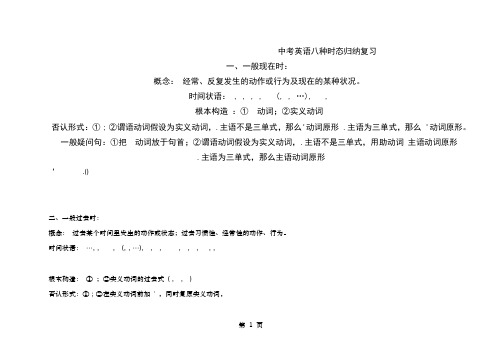
中考英语八种时态归纳复习一、一般现在时:概念:经常、反复发生的动作或行为及现在的某种状况。
时间状语:, , , , (, , …), ,根本构造:① 动词;②实义动词否认形式:① ; ②谓语动词假设为实义动词,.主语不是三单式,那么'动词原形 .主语为三单式,那么 '动词原形。
一般疑问句:①把动词放于句首;②谓语动词假设为实义动词,.主语不是三单式,用助动词主语动词原形.主语为三单式,那么主语动词原形’ .()二、一般过去时:概念:过去某个时间里发生的动作或状态;过去习惯性、经常性的动作、行为。
时间状语:…, , , (, , …), , , , , , , ,根本构造:① ;②实义动词的过去式( , , )否认形式:① ; ②在实义动词前加' ,同时复原实义动词,即’动词原形一般疑问句:① 或放于句首;②用助动词的过去式提问,同时复原实义动词。
.() .()三、现在进展时:概念:表示现阶段或说话时正在进展的动作及行为。
时间状语:, , , ,根本构造:否认形式: .一般疑问句:把动词放于句首。
, .()四、过去进展时:概念:表示过去某段时间或某一时刻正在发生或进展的行为或动作。
时间状语:, , ,或以引导的谓语动词是一般过去时的时间状语等。
根本构造:否认形式: .一般疑问句:把或放于句首。
.().()五、现在完成时:概念:过去发生或已经完成的动作对现在造成的影响或结果,或从过去已经开场,持续到现在的动作或状态。
时间状语:…… , , , , , (几年来,这么多年来),主〔现完〕从〔一过〕〔注意与的区别〕,根本构造:否认形式: .一般疑问句:或主语.()六、过去完成时:概念:以过去某个时间为标准,在此以前发生的动作或行为,或在过去某动作之前完成的行为,即“过去的过去〞。
时间状语:(, …) 过去的时间,主(过完)从(一过)根本构造: . 否认形式: .一般疑问句:放于句首。
专题10 动词的时态和语态(课件)-2024年中考英语复习(全国通用)

14.(2022·湖北武汉·统考中考真题)—I don’t think sixteen-year-olds should be allowed
to drive. —I ________. It’s not safe. A.agree B.agreed C.will agree
D.had agreed
apples in the fridge now.
A.is
B.are
C.was
D.were
【答案】A 【解析】句意:现在冰箱里有一些果汁和几个苹果。考查一般现在时及 “there be”。根据“now”,排除过去时态的CD,由于there be的就近原则, some juice不可数,所以应是is。故选A。
5.(2023·甘肃白银·校考一模)Thanks to those cleaners who ________ hard on the streets, we can have a beautiful city. A.work B.worked C.have worked D.were working
真理。
时态的辨析 满分秘籍
易失分点
提分特训
时态 谓语动词
意义
例句
一般
表示过去
过去 was/were,did 的动作或
时
状态。
When he was a child, he often swam in the river.当他小的时候,他经常在河里游泳。
16.(2023·江苏南通·统考一模)—What will the weather be like tomorrow? —I was on the phone and ________ most of the weather report. A.have missed B.was missing C.will miss D.missed
必备英语中考英语 动词的时态考点解析(Word版附答案)

必备英语中考英语动词的时态考点解析(Word版附答案)一、初中英语动词的时态1.— Peter, what will you do next Sunday?— We ______ our grandparents.A.visit B.visited C.is visiting D.will visit【答案】D【解析】【详解】句意:彼得,下周日你们打算做什么?—我们要去看望我们的祖父母。
本题考查的是时态的辨析,根据问句中的next Sunday可知,本题是一般将来时,故答案选D。
2.—Shall we play tennis now?—Sorry, I can’t. I my homework.A.do B.did C.have done D.am doing【答案】D【解析】句意:——我们现在打网球去好吗?——对不起,我不能去,我在做作业。
A. do 做,用于一般现在时态,主语复数时; B. did做,用于一般过去时态; C. have done 做,用于一般现在完成时态; D. am doing做,用于现在进行时态,主语是I时;根据now可知用现在进行时态,故选D3.—Linda is not coming for the party tonight.—But she _.A.promises B.promised C.will promise D.had promised【答案】B【解析】【详解】句意:---琳达今晚不来参加晚会了吗?----但她答应了。
考查动词时态。
A. promises一般现在时,第三人称单数;B. promised一般过去时;C. will promise一般将来时;D. had promised过去完成时。
根据上文是现在进行时,结合语境可知原先答应,可知用一般过去时。
故选B。
4.—I ________ you at seven and you didn’t pick up.—I was taking a shower at that time.A.call B.calledC.am calling D.have called【答案】B【解析】句意:——我七点钟打电话给你,你没接。
中考英语专项复习专题【动词时代】(附例题以及答案)
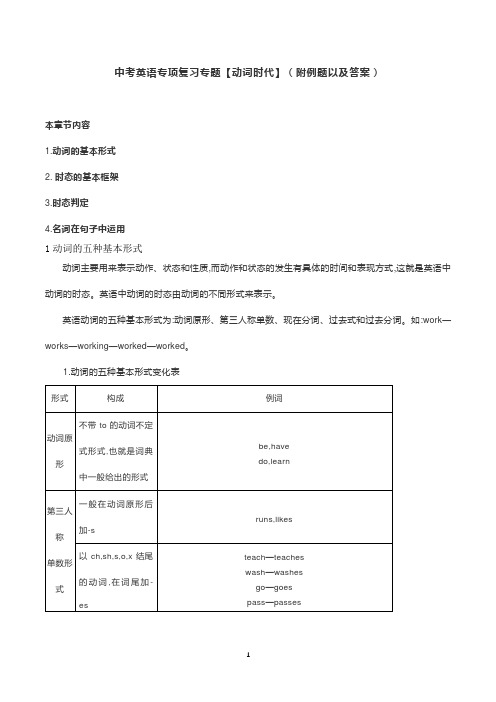
中考英语专项复习专题【动词时代】(附例题以及答案)本章节内容1.动词的基本形式2. 时态的基本框架3.时态判定4.名词在句子中运用1动词的五种基本形式动词主要用来表示动作、状态和性质,而动作和状态的发生有具体的时间和表现方式,这就是英语中动词的时态。
英语中动词的时态由动词的不同形式来表示。
英语动词的五种基本形式为:动词原形、第三人称单数、现在分词、过去式和过去分词。
如:work—works—working—worked—worked。
1.动词的五种基本形式变化表2时态的基本框架常见六种时态的构成及用法(1)一般现在时用法:①现在经常性的状态或动作;②客观事实和真理。
构成:①be+表语;②实义动词作谓语标志词:often, sometimes, usually, always, never,twice a month, every day/week/month/year(every系列)例句:He usually gets to school early.他通常很早到校。
The moon moves around the earth.月亮绕着地球转。
练一练1.认识从实践开始Knowledge practice.2.如果明天下雨,我们就不去公园了。
If it tomorrow,we to the park.【答案】1. begins with.2.rains,won’t go(2)一般过去时用法:表示过去的动作或状态。
构成:①was/were+表语;②实义动词作谓语标志词:a moment ago,just now,ago, yesterday, last night/week/month(last系列)例句:We went to Yunnan last Monday.上周一我们去了云南。
1.She (not visit)her aunt last weekend.2.My friend,Lucy, (study)for the math test and (practice)English last night. 【答案】1.didn’t visit 2.studied practiced(3)一般将来时用法:表示将来的动作或状态。
中考英语动词时态综合复习策略完形填空题40题(带答案)

中考英语动词时态综合复习策略完形填空题40题(带答案)1I love my school life. I always get up early in the morning. I ___1___ breakfast at home and then go to school. At school, we have many interesting classes. We ___2___ Chinese, English, math and other subjects. After school, I often play basketball with my friends. Sometimes I go home and do my homework. I ___3___ very busy but happy.1. A. have B. has C. had D. will have答案:A。
这里表示日常的动作,用一般现在时,主语是I,所以用have。
B 选项has 是第三人称单数形式;C 选项had 是一般过去时;D 选项will have 是一般将来时,都不符合语境。
2. A. learn B. learned C. will learn D. are learning答案:A。
这里也是日常的动作,用一般现在时,主语是we,所以用learn。
B 选项learned 是一般过去时;C 选项will learn 是一般将来时;D 选项are learning 是现在进行时,都不符合语境。
3. A. am B. was C. will be D. have been答案:A。
这里表示现在的状态,用一般现在时,主语是I,所以用am。
B 选项was 是一般过去时;C 选项will be 是一般将来时;D 选项have been 是现在完成时,都不符合语境。
2One day, Tom and his friends decided to go on an adventure in theforest. As they were walking, they heard a strange noise. Tom was curious and wanted to find out what it was. He ___11___ forward slowly. Suddenly, he saw a small animal. It ___12___ very cute.11. A. walked B. walks C. is walking D. was walking答案:D。
初中英语中考必会时态归纳(共16种)
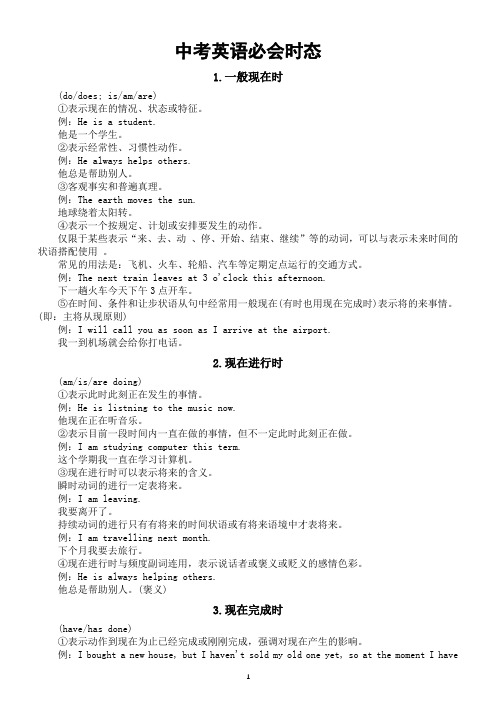
中考英语必会时态1.一般现在时(do/does; is/am/are)①表示现在的情况、状态或特征。
例:He is a student.他是一个学生。
②表示经常性、习惯性动作。
例:He always helps others.他总是帮助别人。
③客观事实和普遍真理。
例:The earth moves the sun.地球绕着太阳转。
④表示一个按规定、计划或安排要发生的动作。
仅限于某些表示“来、去、动、停、开始、结束、继续”等的动词,可以与表示未来时间的状语搭配使用。
常见的用法是:飞机、火车、轮船、汽车等定期定点运行的交通方式。
例:The next train leaves at 3 o'clock this afternoon.下一趟火车今天下午3点开车。
⑤在时间、条件和让步状语从句中经常用一般现在(有时也用现在完成时)表示将的来事情。
(即:主将从现原则)例:I will call you as soon as I arrive at the airport.我一到机场就会给你打电话。
2.现在进行时(am/is/are doing)①表示此时此刻正在发生的事情。
例:He is listning to the music now.他现在正在听音乐。
②表示目前一段时间内一直在做的事情,但不一定此时此刻正在做。
例:I am studying computer this term.这个学期我一直在学习计算机。
③现在进行时可以表示将来的含义。
瞬时动词的进行一定表将来。
例:I am leaving.我要离开了。
持续动词的进行只有有将来的时间状语或有将来语境中才表将来。
例:I am travelling next month.下个月我要去旅行。
④现在进行时与频度副词连用,表示说话者或褒义或贬义的感情色彩。
例:He is always helping others.他总是帮助别人。
(褒义)3.现在完成时(have/has done)①表示动作到现在为止已经完成或刚刚完成,强调对现在产生的影响。
人教版初三英语动词的时态和语态复习
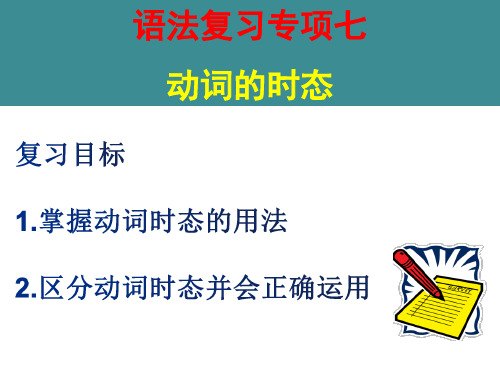
【中考链接】
( ) 1. —I heard your father had gone to Beijing on business.
—Yes. And he ____A___ in three weeks. A. will return B. has returned C. returned D. returns ( ) 2. Just go down this road and you __D_____
等,也常和
等引导的状语从句连用.
★必背句式 It is/has been+一段时间+since+一般过去时
It is/has been five years since he lived in China.
【中考链接】
( ) 1. —Are you going anywhere?
—I __D____ about visiting my sister, but I have changed my mind.
the library next to the bank. A. see B. saw C. have seen D. will see
( ) 3. We ____B___ have a picnic together with our teachers next Thursday.
A. are going B. are going to C. will going D. may going to
B. watches
C.was watching D.watching
3.-----Hey ,what did I say? -----I _________. A. I’m not listening B. I was not listening
英语中考归纳复习专题:动词的时态

英语中考归纳复习专题:动词的时态【动词的时态】初中阶段学习的时态有以下八种:一般现在时、一般过去时、一般将来时、现在进行时、过去进行时、现在完成时、过去完成时、过去将来时.前六种为常考时态,要掌握各时态的构成、用法以及标志性时间状语.【一般现在时】【考点训练1】1.My father is a teacher and he _________ (teach) in a middle school.2.Yesterday the teacher told us the earth _______ (go) around the sun.3.—When shall we begin our meeting?—We’ll begin it when Helen ___ . ()esB.cameC.will comee4.—How do you usually go to school?—I usually ___ to school on foot. ()A.goB.wentC.was goingD.will go答案:teaches goes A A【一般过去时】要点提醒:“used to+动词原形”表示过去的习惯或状态.如:Mum used to tell us stories.妈妈过去常给我们讲故事.【考点训练2】1.Mike ________ (not go) to bed until 12 o’clock last night.2.He asked if I _____ (be) a student.3.Will you please say it again?I ___ quite ___ you.()A.don’t;hearB.didn’t;hearC.don’t;heardD.didn’t;heard4.He _____ go out with his parents,but now he ____ staying at home alone. ()ed to;is used toB.is used to;used toe to;is used toed to;used to答案:didn’t go was B A【一般将来时】要点提醒:be going to与will的区别1.be going to 指已计划好的事或思考过的意图、打算,will表示未事先思考或未计划而临时做出的决定.如:I’m going to see him tomorrow.我打算明天去看他.(事先经过思考)I’ll answer the door.我去开门.(未经事先考虑)2.be going to可表示客观迹象表明马上要发生的事,而will则表明说话者的主观意愿.如:Look at the clouds.There is going to be a storm.看看这些云,暴风雨就要来了.(客观迹象表明要发生)I hope it will be warm tomorrow.我希望明天会暖和起来.(主观意愿)3.在含有条件状语从句的复合句的主句中,一般用will,不用be going to. 如:I will come if it doesn’t rain.如果不下雨的话,我就来.【考点训练3】1.____ a concert in our school next Saturday. ()A.There isB.There areC.There will beD.There will have2.If they can arrive by 9:00 am,we ___ a meeting.()A.haveB.will haveC.hadD.would have3.He ___ her a beautiful hat on her next birthday.()A.givesB.gaveC.will givingD.is going to give答案:C B D 【现在进行时】【考点训练4】1.They ____________ (have) a math test in the classroom now.2.Look! He ___________ (lie) on the beach.3.—Pass the raincoat to me.It ___ hard now.—Here you are. ()A.rainB.is rainingC.rainedD.will rain4.—Cathy,can you answer the door?I ___ the room.—I’m coming,Mum. ()A.CleanB.cleanedC.have cleanedD.am cleaning答案:are having is lying B D【过去进行时】He was forever com plaining about something.他老是怨这怨那.要点提醒:1.在含有时间状语从句的复合句中,延续时间较长的动作常用过去进行时,另一个短暂性动作用一般过去时.如:When the UFO landed,I was shopping at the clothes store.当UFO落地时,我正在服装店买衣服.2.表示两个延续性动作在过去某一时刻同时进行,不考虑动作的先后顺序,主句和从句的谓语动词都用过去进行时,连词常用while.如:Tom was doing his homework while I was reading a newspaper.我在看报纸时,汤姆在做作业.【考点训练5】1.Mike and I ___________ (play) basketball at that time yesterday afternoon.2.While Mr.Johnson _______________ (work) in the office,the phone rang.3.The girl ___ for the bus when the rainstorm came.()A.waitedB.have waitedC.is waitingD.was waiting4.—Jenny,I called you at nine last night,but you didn’t pick up.—Oh,I ____ a popular program called Go Fighting!.()A.watchB.watchedC.was watchingD.am watching答案:were playing was working D C【现在完成时】要点提醒:1.have/has been to,have/has gone to与have/has been in(考点讲解详见P74考点1)2.延续性动词与非延续性动词英语中的动词按动作发生的方式、发生过程的长短可分为延续性动词和非延续性动词两种,非延续性动词也可称为短暂性动词或瞬间动词.在现在完成时态中,有时要将非延续性动词转换为延续性动词,这样才能和时间段连用.转换方法如下:(1)将短暂性动词转换为“be+形容词或副词”.请看下表:如:这间商店开门6小时了.The shop has opened for 6 hours.( ×)The shop has been open for 6 hours.( √)(2)有的短暂性动词可以转换为意思相同的延续性动词.请看下表:如:这本书我借了一个月了.I have borrowed the book for one month.( ×)I have kept the book for one month.( √)3.现在完成时与一般过去时的区别现在完成时强调某一动作或状态对现在造成的影响或结果,不能和表示过去的时间状语连用;一般过去时只表示过去的事实,不表示和现在的关系,可以和表示过去的时间状语连用.如I bought a ticket yesterday.我昨天买了一张票.(强调我昨天做的一件事是买票)I have already bought a ticket.我已经买了一张票.(强调我已经有票了,无须再惦记票的事了)4.现在完成时的其他句型【考点训练6】1.—you _____ your homework yet?—Yes.I ______ it a moment ago. ()A.Did;do;finishedB.Have;done;finishedC.Have;done;have finishedD.Will;do;finish2.His father ___ the Party since 1978. ()A.joinedB.has joinedC.was inD.has been in3.Miss Green isn’t in the office.She to the library. ()A.has goneB.wentC.will goD.has been 答案:B D A【过去完成时】had + 过去分词表示在过去的过去发生的动作或存在的状态.I had had three pieces of cake when you arrived.你来的时候我已经吃了三块蛋糕了.表示过去某一动作或状态持续到过去另一时间.The old man had lived in Shanghai for ten years beforeTom came here.汤姆来这儿之前,这个老人已经住在上海十年了.时间标志by the time...,before,when等构成的短语或引导的从句【考点训练7】1.在我们到达电影院之前,电影已经开始了.The film __________ before we _______ to the cinema.2.警察赶到时,小偷已经逃跑了.When the police __________,the thief____________________ .答案:had begun got arrived had run away 【过去将来时】【考点训练8】1.李明说如果布莱恩下个月来中国,他将会很高兴.Li Ming said he ___________ happy if Brian came to China the next month.2.蒂娜说她下周三打算来参加我的生日派对.Tina said she ________________ my birthday party the next Wednesday.答案:would be was going to【中考示例】(2017·广西)If he _____ Guilin,he’ll probably go to Yangshuo. ( )A.visitsB.is visitingC.will visitD.has visited【解析】考查动词的时态.句意:如果他游览桂林,他有可能会去阳朔.if引导条件状语从句时,时态遵循“主将从现”原则,从句中用一般现在时表示将来.【考题热身】1.(2017·甘肃)I promise I ________ (send) you an email to explain all of these tomorrow.2.(2017·甘肃)Be quiet! The patients ______________(sleep).3.(2017·鄂州)Sandy’s grandparents__________________ (marry) for 50 years.4.(2017·台州改编)A true friend always ____________(support) you whenever youare in trouble.5.(2017·宿迁)I ______________(wash) the dishes while my sister was sweeping the floor.6.(2017·云南)—What do you think of your hometown, Kate?—It a lot.It’s more beautiful than before. ()A.has changedB.changesC.will changeD.change7.(2017·武汉)—Linda is not coming for the party tonight.—But she ______!()A.promisesB.promisedC.will promiseD.had promised8.(2017·毕节)It’s nice to see you again.We ___ each other since 2016. ()A.won’t seeB.haven’t seenC.don’t seeD.didn’t see9.(2017·黔东南)If it doesn’t rain this weekend,we ___ a picnic in the Jinquan Park. ()A.haveB.will haveC.have hadD.had10.(2017·上海)Some exchange students ___ with their host families this time yesterday. ()A.are chattingB.will chatC.were chattingD.have chatted11.(2017·重庆B卷)—Where is your uncle?I haven’t seen him for a long time. —He _____ Beijing for about half a year.He moved there in January. ()A.has gone to B.has been toC.has arrived inD.has been in12.(2017·重庆B卷)John and I ___ to visit his grandparents last Sunday afternoon. ()A.goB.wentC.will goD.have gone13.(2017·重庆A卷)In the past few years,many schools ____ the ways of doing morning exercises. ()A.changeB.changesC.will changeD.have changed14.(2017·重庆A卷)As soon as the rain _____ ,they will go out to pick apples. ()A.stopsB.stoppedC.will stopD.is stopping15.(2017·河北)Don’t take the dictionary away.I ___ it. ()eedC.am usingD.have used答案:will send are sleeping have been married supports A B BBCDBDAC。
中考英语总复习 专题10 动词的时态和语态课件

归纳现在进行时的构成
主语+am/is/are+动词-ing形式
现在进行时的用法
1.表示(biǎoshì)现在(指说话人说话时)正在发生的事情。如: We are waiting for you. 我们正在等你。 2.表示当前一段时间内的活动或现阶段正在进行的动作。如: Mr.Green is writing another novel these days.
A.takes B.took
C.will take D.has taken
第五页,共二十三页。
归纳一般过去时的构成
主语+was/were/did+其他 一般过去时的用法 (1)表示过去某个时间或某一段时间内发生的动作或存在(cúnzài)的状 态。常见的时间状语有:yesterday,last week,an hour ago,the other day,in 1982等。如: Where did you go just now?
您还要些什么吗?
I wondered if you could help me. 我在想你能不能帮我一下。
②情态动词 could,would。如:
Could you lend me your bike? 你的自行车能借我用一下吗?
第七页,共二十三页。
(三)现在(xiànzài)进行时
第八页,共二十三页。
(一)常考的被动语态
A.Invites
C.was invited
B.is invited
D.has invited
第十八页,共二十三页。
2.(2017—2018学年(xuénián)安徽合肥蜀山50中西区第三次月考)If more salt
C to the soup,it will taste better. A.will add B.adds C.is added D.will be added 3.(2018·安徽合肥庐阳区二模,44)All the people I have known in the past three
英语语法复习——八大时态

中考英语语法复习——八大时态初中英语八大时态(讲与练)(一)谓语动词的形式:英语的时态是通过谓语动词的变化来体现的。
因此,了解谓语动词的形式及其变化规律非常重要。
英语的实义动词有以下五种形式:(1) 动词原形:动词原形在句子中形式不变。
主要用于主语为第一、二人称的一般现在时,情态动词之后,或根据语法规定必须用动词原形的其他情况。
(2) 一般现在时第三人称单数形式(简称现单三):主要用于主语为第三人称单数的一般现在时。
(3) 过去式:主要用于一般过去时。
(4) 现在分词:主要用于进行时态。
(5) 过去分词:主要用于完成时态,或被动语态。
谓语动词一般现在时第三人称单数(现单三)的构成,见下表:写和读音规则如下表:的不规则动词表。
谓语动词现在分词一律由动词原形加-ing构成,规则如下表:“时态”就是通过谓语动词的形态变化,来表达动作发生的时间(现在、过去、将来、过去将来)及所处的状态(一般、进行、完成、完成进行)。
1、一般现在时(1)构成:通常以动词原形表示。
主语为第三人称单数时,用单三形式。
(2)用法:1)表示现状、性质、状态和经常的或习惯性的动作。
He has an uncle.他有个叔叔。
Autumn follows summer.夏天之后是秋天。
这些动词可与often, usually, always, sometimes, every day, once a week, on Sundays, never 等表示经常性或习惯性的时间状语连用。
例如:Do you often go to the cinema? 你经常去看电影吗?Tom does not study as hard as Jane. 汤姆在学习方面不如简努力。
My father never takes a bus; he walks to his office.我父亲从来不坐公共汽车,他走着去上班。
2)表示客观现实或普遍真理。
The sun rises in the east. 太阳从东方升起。
中考英语动词的时态答题技巧及练习题(含答案)
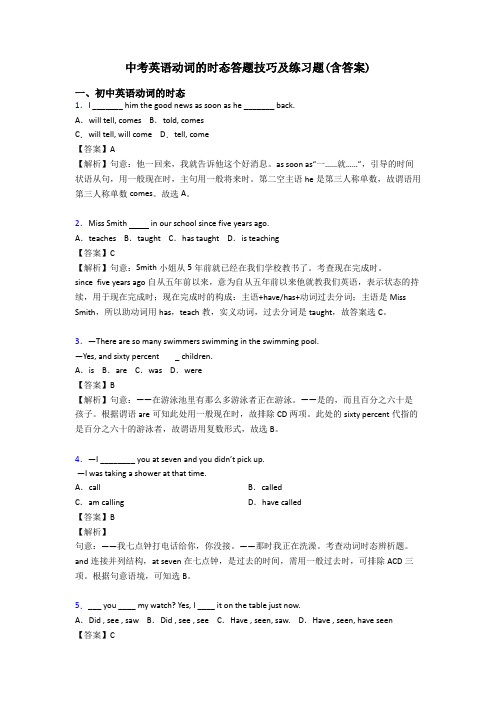
中考英语动词的时态答题技巧及练习题(含答案)一、初中英语动词的时态1.I _______ him the good news as soon as he _______ back.A.will tell, comes B.told, comesC.will tell, will come D.tell, come【答案】A【解析】句意:他一回来,我就告诉他这个好消息。
as soon as“一……就……”,引导的时间状语从句,用一般现在时,主句用一般将来时。
第二空主语he是第三人称单数,故谓语用第三人称单数comes。
故选A。
2.Miss Smith in our school since five years ago.A.teaches B.taught C.has taught D.is teaching【答案】C【解析】句意:Smith小姐从5年前就已经在我们学校教书了。
考查现在完成时。
since five years ago自从五年前以来,意为自从五年前以来他就教我们英语,表示状态的持续,用于现在完成时;现在完成时的构成:主语+have/has+动词过去分词;主语是Miss Smith,所以助动词用has,teach教,实义动词,过去分词是taught,故答案选C。
3.—There are so many swimmers swimming in the swimming pool.—Yes, and sixty percent _ children.A.is B.are C.was D.were【答案】B【解析】句意:——在游泳池里有那么多游泳者正在游泳。
——是的,而且百分之六十是孩子。
根据谓语are可知此处用一般现在时,故排除CD两项。
此处的sixty percent代指的是百分之六十的游泳者,故谓语用复数形式,故选B。
4.—I ________ you at seven and you didn’t pick up.—I was taking a shower at that time.A.call B.calledC.am calling D.have called【答案】B【解析】句意:——我七点钟打电话给你,你没接。
- 1、下载文档前请自行甄别文档内容的完整性,平台不提供额外的编辑、内容补充、找答案等附加服务。
- 2、"仅部分预览"的文档,不可在线预览部分如存在完整性等问题,可反馈申请退款(可完整预览的文档不适用该条件!)。
- 3、如文档侵犯您的权益,请联系客服反馈,我们会尽快为您处理(人工客服工作时间:9:00-18:30)。
中考英语动词时态复习中考英语动词时态复习11 动词的时态111 一般现在时的用法1)经常性或习惯性的动作,常与表示频腮度的时间状语连用。
时间状语:ever…, seties, at…, n Sunda。
例如:I leave he fr shl at 7 ever rning 每天早上我七点离开家。
2)客观真理,客观存在,科学事实。
例如:The earth ves arund the sun 地球绕太阳转动。
Shanghai lies in the east f hina 上海位于中国东部。
3)表示格言或警句。
例如:Pride ges befre a fall 骄者必败。
注意:此用法如果出现在宾语从句中,即使主句是过去时,从句谓语也要用一般现在时。
例:lubus prved that the earth is rund 哥伦布证实了地球是圆的。
4)现在时刻的状态、能力、性格、个性。
例如:I dn’t ant s uh 我不要那么多。
Ann rites gd English but des nt spea ell 安英语写得不错,讲的可不行。
比较:N I put the sugar in the up 把糖放入杯子。
I a ding her n 我正在做功。
第一句用一般现在时,用于操作演示或指导说明的示范性动作,表示言行的瞬间动作。
第二句中的n是进行时的标志,表示正在进行的动作的客观状况,所以后句用一般现在时。
返回动词的时态目录112 一般过去时的用法1)在确定的过去时间里所发生的动作或存在的状态。
例如:时间状语有:esterda, last ee, an hur ag, the ther da, in 1982等。
例如:here did u g ust n? 刚才你上哪儿去了?2)表示在过去一段时间内,经常性或习惯性的动作。
例如:hen I as a hild, I ften plaed ftball in the street 我是个孩子的时候,常在马路上踢足球。
henever the Brns ent during their visit, the ere given a ar ele那时,布朗一家无论什么时候去,都受到热烈欢迎。
3)句型:It is tie fr sb t d sth “到……时间了” “该……了”。
例如:It is tie fr u t g t bed 你该睡觉了。
It is tie that sb did sth “时间已迟了” “早该……了” ,例如It is tie u ent tbed 你早该睡觉了。
uld (had)rather sb did sth 表示’宁愿某人做某事’。
例如:I’d rather u ae trr还是明天吧。
4)ish, nder, thin, hpe 等用过去时,作试探性的询问、请求、建议等,而一般过去时表示的动作或状态都已成为过去,现已不复存在。
例如:I thught u ight have se 我以为你想要一些。
比较:hristine as an invalid all her life(含义:她已不在人间。
)hristine has been an invalid all her life(含义:她现在还活着)rs Darb lived in entu fr seven ears (含义:达比太太已不再住在肯塔基州。
)rs Darb has lived in entu fr seven ears (含义:现在还住在肯塔基州,有可能指刚离去)注意:用过去时表示现在,表示委婉语气。
1)动词ant, hpe, nder, thin, intend 等。
例如:Did u ant anthing else? 您还要些什么吗?I ndered if u uld help e 能不能帮我一下。
2)情态动词uld, uld。
例如:uld u lend e ur bie? 你的自行车,能借用一些吗?返回动词的时态目录113 used t / be used tused t + d:”过去常常”表示过去习惯性的动作或状态,但如今已不存在。
例如:ther used nt t be s frgetful 老妈过去没那么健忘。
Sarf used t tae a al 斯卡夫过去常常散步。
be used t + ding:对……已感到习惯,或”习惯于”,t是介词,后需加名词或动名词。
例如:He is used t a vegetarian dietSarf is used t taing a al 斯卡夫现在已习惯于散步了。
典型例题---- ur phne nuber again? I ___ quite ath it---- It’s 6968442A didn’tB uldn’t dn’t D an’t答案A 本句虽没有明确的时间状语,但从语意上看出,在听的时候没有听懂这个动作发生在过去,因此应用过去时。
返回动词的时态目录114 一般将时1)shall用于第一人称,常被ill 所代替。
ill 在陈述句中用于各人称,在征求意见时常用于第二人称。
例如:hih paragraph shall I read first?我先读哪一段呢?ill u be at he at seven this evening? 今晚七点回家好吗?2)be ging t +不定式,表示将。
a 主语的意图,即将做某事。
例如:hat are u ging t d trr? 明天打算作什么呢?b 计划,安排要发生的事。
例如:The pla is ging t be prdued next nth。
这出戏下月开播。
有迹象要发生的事。
例如:L at the dar luds, there is ging t be a str 看那乌云,快要下雨了。
3)be +不定式表将,按计划或正式安排将发生的事。
例如:e are t disuss the reprt next Saturda我们下星期六讨论这份报告。
4)be abut t +不定式,意为马上做某事。
例如:He is abut t leave fr Beiing 他马上要去北京。
注意:be abut t d 不能与trr, next ee 等表示明确将时的时间状语连用。
返回动词的时态目录11 be ging t / ill 用于条句时,be ging t表将,ill表意愿。
例如:If u are ging t ae a urne, u’d better get read fr it as sn as pssibleN if u ill tae ff ur lthes, e ill fit the ne lthes n u in frnt f the irrr返回动词的时态目录116 be t和be ging tbe t 表示客观安排或受人指示而做某事,be ging t 表示主观的打算或计划。
例如:I a t pla ftball trr afternn 明天下午我去踢球。
(客观安排)I’ ging t pla ftball trr afternn 明天下午我想去踢球。
(主观安排)返回动词的时态目录117 一般现在时表将1)下列动词e, g, arrive, leave, start, begin, return的一般现在时可以表示将,主要用表示在时间上已确定或安排好的事情。
例如:The train leaves at six trr rning 火车明天上午六点开。
hen des the bus star? It stars in ten inutes 汽车什么时候开?十分钟后。
2)以here, there等开始的倒装句,表示动作正在进行。
例如:Here es the bus = The bus is ing 车了。
There ges the bell = The bell is ringing 铃响了。
3)在时间或条句中。
例如:hen Bill es (不是ill e), as hi t ait fr e 比尔后,让他等我。
I’ll rite t u as sn as I arrive there 我到了那里,就写信给你。
4)在动词hpe, tae are that, ae sure that等的宾语从句中。
例如:I hpe the have a nie tie next ee 我希望他们下星期玩得开心。
ae sure that the inds are lsed befre u leave the r 离开房间前,务必把窗户关了。
返回动词的时态目录118 用现在进行时表示将下列动词e, g, arrive, leave, start, begin, return等现在进行时可以表示将。
例如:I’ leaving trr 明天我要走了。
Are u staing here till next ee? 你会在这儿呆到下周吗?返回动词的时态目录119 现在完成时现在完成时用表示之前已发生或完成的动作或状态,其结果的影响现在还存在;也可表示持续到现在的动作或状态。
其构成:have (has)+过去分词。
返回动词的时态目录1110 比较一般过去时与现在完成时1)一般过去时表示过去某时发生的动作或单纯叙述过去的事情,强调动作;现在完成时为过去发生的,强调过去的事情对现在的影响,强调的是影响。
2)一般过去时常与具体的时间状语连用,而现在完成时通常与模糊的时间状语连用,或无时间状语。
一般过去时的时间状语:esterda, last ee,…ag, in1980, in tber, ust n等,皆为具体的时间状语。
现在完成时的时间状语:fr, sine, s far, ever, never, ust, et, till/until, up t n, in past ears, alas等,皆不确定的时间状语。
共同的时间状语:this rning, tnight, this April, n, alread, reentl, latel 等。
3)现在完成时可表示持续到现在的动作或状态,动词一般是延续性的,如live, teah, learn, r, stud, n。
一般过去时常用的非持续性动词有e, g, leave, start, die, finish, bee, get arried等。
例如:I sa this fil esterda (强调看的动作发生过了)I have seen this fil (强调对现在的影响,电影的内容已经知道了)h did u get up s earl? (强调起床的动作已发生过了)h hasn’t handed in his paper? (强调有卷子未交,疑为不公平竞争)He has been in the League fr three ears (在团内的状态可延续)He has been a League eber fr three ears (是团员的状态可持续)句子中如有过去时的时间副词(如esterda, last, ee, in 1960)时,不能使用现在完成时,要用过去时。
